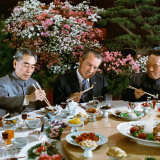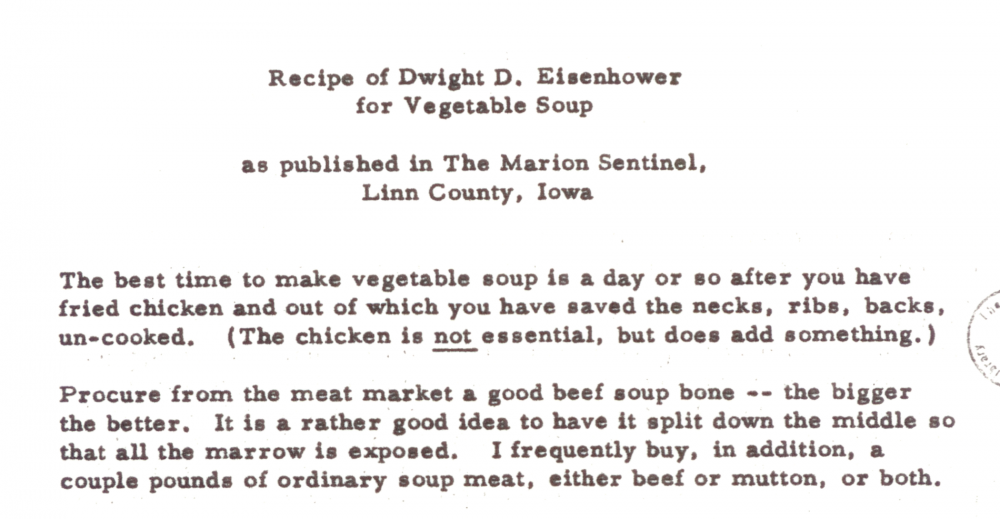“It’s incredible, you should try this, Chris,” says Alex Prud’homme, author of Dinner with the President: Food, Politics, and Breaking Bread at the White House. He joined us on Milk Street Radio to share stories from the book, and was talking here about his favorite recipe from presidential history: Dwight Eisenhower’s Two-Day Vegetable Soup.
According to Prud’homme, Eisenhower may have been the most accomplished presidential cook, and one of his signature dishes swept the nation. “This recipe was so popular that it was reprinted all across the country,” he says. “It made headlines.”
Take Alex’s advice and try out the soup for yourself.
Recipe of Dwight D. Eisenhower for Vegetable Soup
The best time to make vegetable soup is a day or so after you have fried chicken and out of which you have saved the necks, ribs, backs, un-cooked. (The chicken is not essential, but does add something.) Procure from the meat market a good beef soup bone — the bigger the better. It is a rather good idea to have it split down the middle so that all the marrow is exposed. I frequently buy, in addition, a couple pounds of ordinary soup meat, either beef or mutton, or both.
Put all this meat, early in the morning, in a big kettle. The best kind is heavy aluminum, but a good iron pot will do almost as well. Put in also the bony parts of the chicken you have saved. Cover it with water, something on the order of 5 quarts. Add a teaspoon of salt, a bit of black pepper and, if you like, a touch of garlic (one small piece). If you don't like garlic, put in an onion. Boil all this slowly all day long. Keep on boiling till the meat has literally dropped off the bone. If your stock boils down during the day, add enough water from time to time to keep the meat covered. When the whole thing has practically disintegrated, pour out into another large kettle through a colander. Make sure that the marrow is out of the bones. I advise you to let this drain through the colander for quite a while as much juice will drain out of the meat. (Shake the colander well to help get out all the juice.)
I usually save a few of the better pieces of meat to be diced and put into the soup after it is done. The rest of it can be given to your dogs or your neighbor's chickens. Put the kettle containing the stock you now have in a very cool place, outdoors in the wintertime or in the ice box; let it stand all night and the next day until you are ready to make your soup.
You will find that a hard layer of fat has formed on top of the stock which can usually be lifted off since the whole kettle full of stock has jelled. Some people like a little bit of the fat left on, and I know a few who like their soup very rich and do not remove more than about half of the fat.
Put the stock back into your kettle and you are now ready to make your soup.
In a separate pan, boil slowly about a third of a teacupful of barley. This should be cooked separately since it has a habit, in a soup kettle, of settling to the bottom and if your fire should happen to get too hot it is likely to burn. If you cannot get barley use rice, but it is a poor substitute.
One of the secrets of making good vegetable soup is not to cook any of the vegetables too long. However, it is impossible to give you an exact measure of the vegetables you should put in because some people like their vegetable soup almost as thick as stew, others like it much thinner. Moreover, sometimes you can get exactly the vegetables you want; other times you have to substitute. Where you use canned vegetables, put them in only a few minutes before taking the soup off the fire. If you fresh ones, naturally they must be fully cooked in the soup.
The things I like to put into my soup are about as follows:
1 quart of canned tomatoes
1/2 teacup of fresh peas. If you can't get peas, a handful of good green beans cut up very small can substitute
2 normal sized potatoes, diced into cubes of about half-inch size
1 good-sized onion (sliced)
3 nice-sized carrots diced about the same size as potatoes
1 turnip diced like the potatoes
1/2 cup of canned corn
A handful of raw cabbage cut up in small pieces
Your vegetables should not all be dumped in at once. The potatoes, for example, will cook more quickly than the carrots. Your effort must be to have them all nicely cooked but not mushy, at about the same time.
The fire must not be too hot, but the soup should keep bubbling.
When you figure the soup is about done, put in your barley which should now be fully cooked, add a tablespoonful of "Kitchen Bouquet" and a taste for flavoring, particularly salt and pepper and, if you have it. Use some onion salt, garlic salt and celery salt. (If you cannot get "Kitchen Bouquet," use one teaspoonful of Lee and Perrin's Worcestershire Sauce.)
Cut up the few bits of the meat you have saved and put about a small handful into the soup.
While you are cooking the soup, do not allow the liquid to boil down too much. Add a bit of water from time to time. If your stock was good and thick when you started, you can add more water than if it was thin when you started.
As a final touch, in the springtime when nasturtiums are green and tender, you can take a few nasturtium stems, cut them up in a small pieces, boil them separately as you did the barley, and add them to your soup. (About one tablespoonful after cooking.)
Accessed through the National Archives.
Join the conversation on Facebook, Twitter, Instagram and Pinterest.
And if you're looking for more Milk Street, check out our livestream cooking classes with our favorite chefs, home cooks and friends for global recipes, cooking methods and more.



